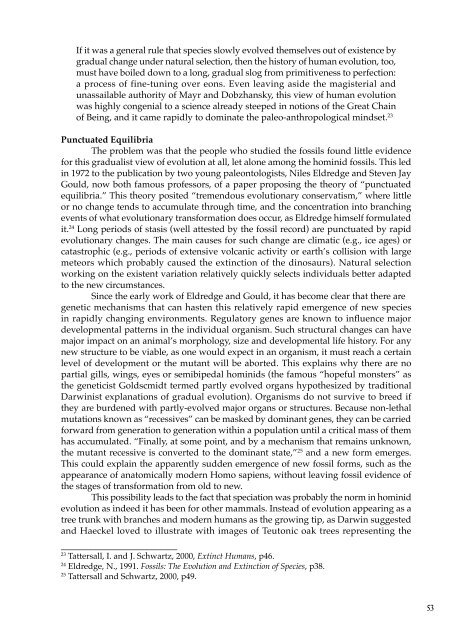The Spirit in Human Evolution - Waldorf Research Institute
The Spirit in Human Evolution - Waldorf Research Institute
The Spirit in Human Evolution - Waldorf Research Institute
Create successful ePaper yourself
Turn your PDF publications into a flip-book with our unique Google optimized e-Paper software.
If it was a general rule that species slowly evolved themselves out of existence by<br />
gradual change under natural selection, then the history of human evolution, too,<br />
must have boiled down to a long, gradual slog from primitiveness to perfection:<br />
a process of f<strong>in</strong>e-tun<strong>in</strong>g over eons. Even leav<strong>in</strong>g aside the magisterial and<br />
unassailable authority of Mayr and Dobzhansky, this view of human evolution<br />
was highly congenial to a science already steeped <strong>in</strong> notions of the Great Cha<strong>in</strong><br />
of Be<strong>in</strong>g, and it came rapidly to dom<strong>in</strong>ate the paleo-anthropological m<strong>in</strong>dset. 23<br />
Punctuated Equilibria<br />
<strong>The</strong> problem was that the people who studied the fossils found little evidence<br />
for this gradualist view of evolution at all, let alone among the hom<strong>in</strong>id fossils. This led<br />
<strong>in</strong> 1972 to the publication by two young paleontologists, Niles Eldredge and Steven Jay<br />
Gould, now both famous professors, of a paper propos<strong>in</strong>g the theory of “punctuated<br />
equilibria.” This theory posited “tremendous evolutionary conservatism,” where little<br />
or no change tends to accumulate through time, and the concentration <strong>in</strong>to branch<strong>in</strong>g<br />
events of what evolutionary transformation does occur, as Eldredge himself formulated<br />
it. 24 Long periods of stasis (well attested by the fossil record) are punctuated by rapid<br />
evolutionary changes. <strong>The</strong> ma<strong>in</strong> causes for such change are climatic (e.g., ice ages) or<br />
catastrophic (e.g., periods of extensive volcanic activity or earth’s collision with large<br />
meteors which probably caused the ext<strong>in</strong>ction of the d<strong>in</strong>osaurs). Natural selection<br />
work<strong>in</strong>g on the existent variation relatively quickly selects <strong>in</strong>dividuals better adapted<br />
to the new circumstances.<br />
S<strong>in</strong>ce the early work of Eldredge and Gould, it has become clear that there are<br />
genetic mechanisms that can hasten this relatively rapid emergence of new species<br />
<strong>in</strong> rapidly chang<strong>in</strong>g environments. Regulatory genes are known to <strong>in</strong>fluence major<br />
developmental patterns <strong>in</strong> the <strong>in</strong>dividual organism. Such structural changes can have<br />
major impact on an animal’s morphology, size and developmental life history. For any<br />
new structure to be viable, as one would expect <strong>in</strong> an organism, it must reach a certa<strong>in</strong><br />
level of development or the mutant will be aborted. This expla<strong>in</strong>s why there are no<br />
partial gills, w<strong>in</strong>gs, eyes or semibipedal hom<strong>in</strong>ids (the famous “hopeful monsters” as<br />
the geneticist Goldscmidt termed partly evolved organs hypothesized by traditional<br />
Darw<strong>in</strong>ist explanations of gradual evolution). Organisms do not survive to breed if<br />
they are burdened with partly-evolved major organs or structures. Because non-lethal<br />
mutations known as “recessives” can be masked by dom<strong>in</strong>ant genes, they can be carried<br />
forward from generation to generation with<strong>in</strong> a population until a critical mass of them<br />
has accumulated. “F<strong>in</strong>ally, at some po<strong>in</strong>t, and by a mechanism that rema<strong>in</strong>s unknown,<br />
the mutant recessive is converted to the dom<strong>in</strong>ant state,” 25 and a new form emerges.<br />
This could expla<strong>in</strong> the apparently sudden emergence of new fossil forms, such as the<br />
appearance of anatomically modern Homo sapiens, without leav<strong>in</strong>g fossil evidence of<br />
the stages of transformation from old to new.<br />
This possibility leads to the fact that speciation was probably the norm <strong>in</strong> hom<strong>in</strong>id<br />
evolution as <strong>in</strong>deed it has been for other mammals. Instead of evolution appear<strong>in</strong>g as a<br />
tree trunk with branches and modern humans as the grow<strong>in</strong>g tip, as Darw<strong>in</strong> suggested<br />
and Haeckel loved to illustrate with images of Teutonic oak trees represent<strong>in</strong>g the<br />
_________________________<br />
23<br />
Tattersall, I. and J. Schwartz, 2000, Ext<strong>in</strong>ct <strong>Human</strong>s, p46.<br />
24<br />
Eldredge, N., 1991. Fossils: <strong>The</strong> <strong>Evolution</strong> and Ext<strong>in</strong>ction of Species, p38.<br />
25<br />
Tattersall and Schwartz, 2000, p49.<br />
53
















